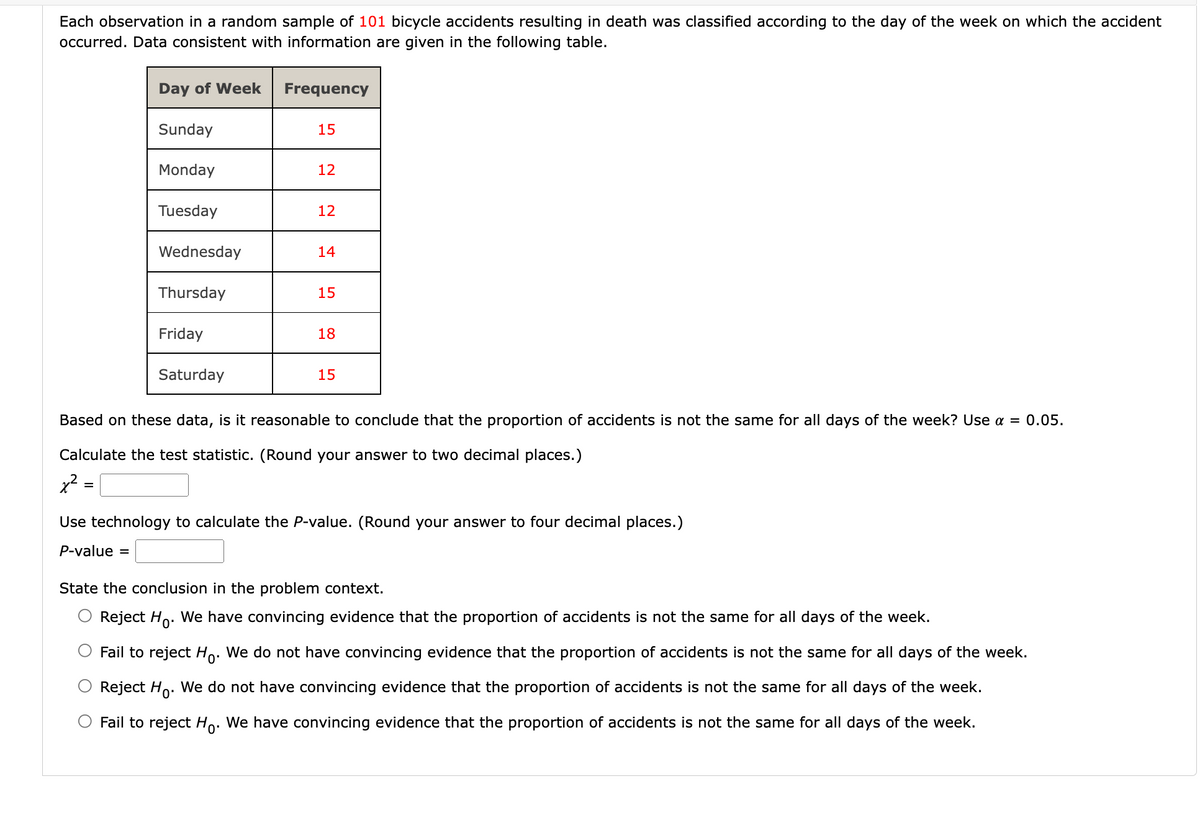Each observation in a random sample of 101 bicycle accidents resulting in death was classified according to the day of the week on which the accident occurred. Data consistent with information are given in the following table. Day of Week Frequency Sunday Monday Tuesday Wednesday Thursday Friday Saturday 15 12 12 14 15 18 15 Based on these data, is it reasonable to conclude that the proportion of accidents is not the same for all days of the week? Use a = 0.05. Calculate the test statistic. (Round your answer to two decimal places.) x² = Use technology to calculate the P-value. (Round your answer to four decimal places.) P-value = State the conclusion in the problem context. O Reject Ho. We have convincing evidence that the proportion of accidents is not the same for all days of the week. O Fail to reject Ho. We do not have convincing evidence that the proportion of accidents is not the same for all days of the week. O Reject Ho. We do not have convincing evidence that the proportion of accidents is not the same for all days of the week. O Fail to reject Ho. We have convincing evidence that the proportion of accidents is not the same for all days of the week.
Each observation in a random sample of 101 bicycle accidents resulting in death was classified according to the day of the week on which the accident occurred. Data consistent with information are given in the following table. Day of Week Frequency Sunday Monday Tuesday Wednesday Thursday Friday Saturday 15 12 12 14 15 18 15 Based on these data, is it reasonable to conclude that the proportion of accidents is not the same for all days of the week? Use a = 0.05. Calculate the test statistic. (Round your answer to two decimal places.) x² = Use technology to calculate the P-value. (Round your answer to four decimal places.) P-value = State the conclusion in the problem context. O Reject Ho. We have convincing evidence that the proportion of accidents is not the same for all days of the week. O Fail to reject Ho. We do not have convincing evidence that the proportion of accidents is not the same for all days of the week. O Reject Ho. We do not have convincing evidence that the proportion of accidents is not the same for all days of the week. O Fail to reject Ho. We have convincing evidence that the proportion of accidents is not the same for all days of the week.
Glencoe Algebra 1, Student Edition, 9780079039897, 0079039898, 2018
18th Edition
ISBN:9780079039897
Author:Carter
Publisher:Carter
Chapter10: Statistics
Section10.4: Distributions Of Data
Problem 19PFA
Related questions
Question

Transcribed Image Text:Each observation in a random sample of 101 bicycle accidents resulting in death was classified according to the day of the week on which the accident
occurred. Data consistent with information are given in the following table.
Day of Week
Sunday
Monday
Tuesday
Wednesday
Thursday
Friday
Saturday
Frequency
15
12
12
14
15
18
15
Based on these data, is it reasonable to conclude that the proportion of accidents is not the same for all days of the week? Use a = 0.05.
Calculate the test statistic. (Round your answer to two decimal places.)
x²
Use technology to calculate the P-value. (Round your answer to four decimal places.)
P-value =
State the conclusion in the problem context.
Reject Ho. We have convincing evidence that the proportion of accidents is not the same for all days of the week.
Fail to reject Ho. We do not have convincing evidence that the proportion of accidents is not the same for all days of the week.
Reject Ho. We do not have convincing evidence that the proportion of accidents is not the same for all days of the week.
Fail to reject Ho. We have convincing evidence that the proportion of accidents is not the same for all days of the week.
Expert Solution
This question has been solved!
Explore an expertly crafted, step-by-step solution for a thorough understanding of key concepts.
Step by step
Solved in 4 steps with 2 images

Recommended textbooks for you

Glencoe Algebra 1, Student Edition, 9780079039897…
Algebra
ISBN:
9780079039897
Author:
Carter
Publisher:
McGraw Hill

Glencoe Algebra 1, Student Edition, 9780079039897…
Algebra
ISBN:
9780079039897
Author:
Carter
Publisher:
McGraw Hill